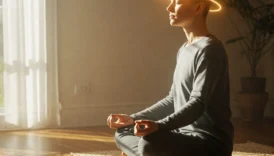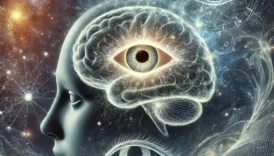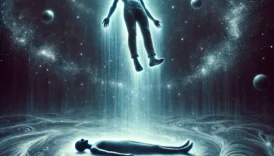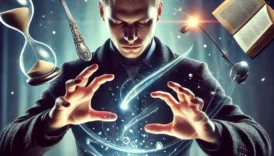Astral Travel and Spiritual Projection
Astral travel and spiritual projection refer to the belief that a person can move beyond their physical body and experience different realms or levels of existence. Throughout history, many cultures have developed narratives, rituals, and practices related to such experiences. In recent years, there has been growing interest in astral travel and spiritual projection within both spiritual circles and popular culture. This article examines what astral travel is, its history, scientific viewpoints, methods of practice, possible benefits and risks, as well as the post-experience process.
- Astral Travel and Spiritual Projection
- Definition of Astral Travel
- Historical Background
- Astral Travel in Ancient Civilizations
- Astral Travel in the Modern Era
- Scientific Approaches
- Methods and Techniques of the Experience
- Astral Travel with Meditation and Breathing Techniques
- Astral Travel Through Lucid Dreaming
- Experiences and Reports During Astral Travel
- Possible Benefits of Astral Travel
- Possible Risks and Concerns of Astral Travel
- Post-Experience Process of Astral Travel
- Frequently Asked Questions About Astral Travel
- General Evaluation
- References
Human curiosity about whether consciousness can exist independently of physical reality—or at least in parallel—underpins the concept of astral travel. From ancient times to the present day, various esoteric teachings and spiritual schools have embraced the idea that people can temporarily leave their bodies and gain experience in a spiritual dimension. Some individuals claim to have been born with the ability to have these experiences, while others believe that one can attain this state through techniques such as meditation and mental exercises. Beyond that, scientists and psychologists have developed different ways of interpreting these experiences, conducting research, and exploring this phenomenon.
Definition of Astral Travel
Astral travel generally refers to a phenomenon in which a person is believed to temporarily separate from their physical body and experience another dimension or spiritual plane. During this experience, the person’s consciousness goes beyond everyday perception and is thought to move through a distinct “astral body.” This “astral body” is often described as a lighter, more energetic form. Astral travel is sometimes associated with what is known as an out-of-body experience (OBE). Although different schools of thought and cultures have various terms for this phenomenon, they share the idea that there is a temporary separation between body and consciousness.
It’s important not to mistake astral travel for mere imagination or a dreamlike state. Many individuals who claim to have had this experience describe it as remarkably vivid and lifelike. According to some, these experiences occur in different layers of existence, each with its own frequency, and communication with other entities or even deceased loved ones is sometimes reported.
Historical Background
The history of astral travel is as old as humanity itself. Numerous ancient civilizations and spiritual traditions developed narratives and practices relating to such out-of-body experiences. When we examine this subject historically, it appears that belief in the soul or consciousness having a separate existence from the body forms its primary underpinning.
Astral Travel in Ancient Civilizations
Astral travel or spiritual projection holds a prominent place particularly in Ancient Egypt, Ancient Greece, and Indian civilizations. For example, the ancient Egyptian Book of the Dead (circa 1550 BCE) is filled with rituals and teachings suggesting that the soul can leave the body and travel through various realms (Source: Egyptian Book of the Dead, Papyrus Texts and Hieroglyphic Writings, traditional compilations). Likewise, in Ancient Greece, philosophers such as Plato discussed the concept of the soul separating from the body.
In Indian culture, deep philosophical discussions on the relationship between soul and body appear in the Upanishads and Vedic texts. Yoga and meditation techniques are considered methods for reaching different states of consciousness and experiencing spiritual projection. In particular, branches like Raja Yoga and Kundalini Yoga are believed to expand one’s states of awareness, enabling out-of-body experiences. In these traditions, spiritual projection is often seen as a step toward discovering one’s true essence.
Astral Travel in the Modern Era
In the modern era, astral travel became popular both in Western esoteric schools and among broader audiences. Particularly in the late 19th and early 20th centuries, the rise of the Spiritualist movement increased interest in spiritual phenomena, and many authors and researchers wrote works on this topic. For example, in their 1929 book, The Projection of the Astral Body, Sylvan Muldoon and Hereward Carrington examined astral projection in detail, referencing numerous personal experiences (Source: Muldoon & Carrington, The Projection of the Astral Body, 1929).
In more recent times, Robert A. Monroe’s 1971 publication Journeys Out of the Body significantly contributed to the popularization of the concept of astral travel in the modern world (Source: Monroe, Journeys Out of the Body, 1971). Monroe provided a detailed account of his own out-of-body experiences and discussed techniques for those wishing to have similar experiences. Likewise, William Buhlman shared numerous astral travel techniques and stories in his 1996 book Adventures Beyond the Body. Collectively, these works offer a rich theoretical and practical foundation for astral travel and spiritual projection in the modern era.
Scientific Approaches
Naturally, astral travel has piqued the curiosity of the scientific community, prompting exploration from various angles. In the field of psychology, some researchers suggest that these experiences may be triggered by changes in the brain’s perception processes. For instance, certain studies have noted that during particular stages of sleep or the transitions between sleep and wakefulness (known as hypnagogic and hypnopompic states), individuals might feel as though they are leaving their bodies (Source: Blackmore, D. (1982). Beyond the Body: An Investigation of Out-of-the-Body Experiences). While some scientists attempt neurological explanations for out-of-body experiences, others regard these as purely subjective events.
Brain hemisphere asymmetry, temporal lobe stimulation, and the brain waves observed during deep meditation have all been linked to astral travel. Some researchers have reported increases in theta and delta waves in individuals who practice intensive meditation (Source: Schulman, R. (1978). EEG Patterns During States of Meditation and Out-of-Body Experiences, Journal of Transpersonal Psychology). However, it’s difficult to claim that these observations and experiments scientifically prove astral travel is real, since this phenomenon is highly subjective and challenging to verify with physical instruments.
Additionally, some parapsychology research has tried to see if individuals can gather information about distant objects or events during astral travel, often employing remote viewing protocols. While findings are inconsistent, certain experimental data suggesting that people might consciously gain information while out-of-body keeps interest and discussion on this subject alive.
Methods and Techniques of the Experience
Various methods and techniques are recommended to induce astral travel or spiritual projection. These methods primarily aim to relax the mind and body, enabling a calm and deeply focused state of consciousness. Below are some of the most widely known and practiced techniques.
Astral Travel with Meditation and Breathing Techniques
Meditation is a fundamental tool for calming the body and mind, enhancing concentration, and deepening awareness. Techniques used to facilitate astral travel often include:
- Progressive Relaxation: Starting at the toes and moving up to the head, the individual methodically relaxes each area of the body. Deep, rhythmic breathing is crucial during this process, allowing all muscle tension to be released.
- Breath Control: Taking slow, deep breaths can quiet the mind and reduce distracting thoughts. Focusing on the breath strengthens concentration and creates the “mental silence” conducive to astral projection.
- Visualization: Once deeply relaxed, the individual may visualize slowly rising above their body or imagine the astral body separating from the physical body. Over time, this visualization can lead to a powerful sensation of an out-of-body experience.
These techniques are particularly suited for beginners, though patience and consistency are required. Results can vary from person to person, given our different mental structures and emotional patterns.
Astral Travel Through Lucid Dreaming
Lucid dreaming, in which an individual is aware they are dreaming and can consciously direct the content of the dream, is closely associated with astral travel. In such a state, various techniques can be applied to transition into astral travel or an out-of-body experience. For example, while lucid, one might “rise upward” from the dream environment or “pass through a door” to enter another dimension. Tips for lucid dreaming include:
- Keeping a Dream Journal: Immediately upon waking, record any dreams in detail to improve dream recall. The better the recall, the greater the chance of becoming lucid.
- Reality Checks: Several times a day, ask yourself, “Am I dreaming right now?” This habit can carry over into your dream state, helping you achieve lucidity.
- Using Mantras: Before falling asleep, repeating affirmations such as, “I will remain conscious in my next dream,” can help promote lucid dreaming.
Many who have reported transitioning to out-of-body experiences or astral projection through lucid dreaming consider it a more direct route, as the mind is already in an “altered state of consciousness.” Nonetheless, time, practice, and discipline are necessary.
Experiences and Reports During Astral Travel
Reports regarding astral travel experiences are highly diverse. Some describe flying through a brightly colored astral realm, while others say they navigate familiar locations that feel “as vivid as physical reality.” Certain accounts mention encountering unfamiliar spiritual beings, communicating with deceased relatives, or other extraordinary events. These elements contribute to astral travel’s reputation as a profoundly spiritual and enriching phenomenon.
Some individuals also report perceiving an “energetic cord” referred to as the “silver cord” during astral travel, linking the astral body with the physical body. This concept frequently appears in various esoteric teachings and spiritual sources (Source: Muldoon & Carrington, 1929). While some people experience complete freedom and bliss, others report fear, anxiety, or discomfort, which can affect the overall quality and duration of the experience.
Common points that stand out in astral travel accounts include:
- Sense of Time: Time may flow differently in the astral realm. Some feel they’ve experienced much in a short span, while others sense that lengthy experiences transpired in an instant.
- Emotional Intensity: Events in the astral dimension are often perceived as more emotionally and sensorially intense.
- Flexibility of Space: Freed from physical laws, people report passing through walls, moving at the speed of light, or reshaping their environment through focused thought.
Possible Benefits of Astral Travel
Many suggest that astral travel can promote spiritual growth, self-awareness, and inner peace. Some potential benefits include:
- Spiritual Growth: By moving beyond the limits of physical reality, individuals may discover the multi-layered nature of existence.
- Overcoming Fears: The sensation of separating from the body can be frightening. Confronting this fear may enhance a person’s inner strength and conviction.
- Creativity and Inspiration: The symbols, colors, and scenarios witnessed during astral travel may provide creative inspiration.
- Energetic Balance: Certain teachers and spiritual guides assert that astral experiences can help balance and cleanse the body’s energy centers (chakras).
- Enhanced Intuition: Out-of-body experiences may heighten one’s insight and intuitive awareness.
Possible Risks and Concerns of Astral Travel
One of the most common questions among those interested in astral travel is whether it involves any danger. Though there is no conclusive evidence of direct physical harm, certain psychological or emotional difficulties can arise:
- Fear and Panic: Strong fear, panic, or anxiety can occur when the astral body separates from the physical body, potentially interrupting the experience.
- Misinterpretation: Symbols or entities encountered during the experience might be misread due to the individual’s mental state, causing anxiety.
- Difficulty Distinguishing Reality: Those who frequently practice astral travel may sometimes find it challenging to separate daily life from these out-of-body experiences.
- Energetic Imbalance: Some esoteric teachings suggest that improper or incomplete techniques could cause energetic imbalances.
Because objective scientific or academic proof of astral travel’s mechanics is lacking, personal belief systems and subjective experiences play a significant role. The best approach is to remain mindful of one’s mental well-being and proceed with balanced exploration.
Post-Experience Process of Astral Travel
The period following an astral travel experience is almost as critical as the experience itself. Individuals returning from an out-of-body state must mentally and emotionally integrate the event in a healthy way. The following practices may help make the aftermath more productive:
- Keeping a Journal or Notes: Record details of the astral experience as thoroughly as possible—colors, emotions, locations, and any beings encountered. Such documentation can increase self-awareness and aid in long-term analysis.
- Meditation or Breathing Exercises: Short meditation or breathing sessions after returning to physical consciousness can help ground the individual and rebalance energies.
- Seeking Guidance: If the experience was very intense or frightening, obtaining advice from a spiritual mentor or therapist can be beneficial. Astral travel might be disorienting to those unaccustomed to spiritual practices.
- Energy Work: Activities like Yoga, Tai Chi, or Reiki may regulate energy post-astral travel and help restore overall balance.
Frequently Asked Questions About Astral Travel
- Can anyone practice astral travel? Many sources claim that with sufficient dedication, patience, and desire, anyone can practice astral travel. However, an individual’s mental and physical health, belief system, and motivation all play key roles.
- How is astral travel different from dreaming? Dreams usually occur unconsciously, with limited control. Astral travel typically involves a higher level of consciousness and is often undertaken deliberately. However, the two experiences can overlap.
- Is there a risk of not being able to return during astral travel? Spiritual sources maintain that an energetic cord connects the astral body to the physical body, and the experience naturally concludes as one returns. Psychologically, the individual can simply choose to wake up or end the experience if desired.
- Can astral travel be proven? No definitive scientific method currently exists to objectively prove astral travel. Most research relies on subjective accounts and personal testimonies.
- Is astral travel the same as remote viewing? While similar, these concepts differ slightly. Remote viewing involves gathering information about a distant location or object, whereas astral travel emphasizes an out-of-body state and spiritual projection.
General Evaluation
Astral travel and spiritual projection have been recognized across different cultures and esoteric teachings for centuries, fueled by our ongoing curiosity about the deeper potential of human consciousness. Through modern writers and researchers, this phenomenon has reached a wider audience and remains a subject of both spiritual and scientific debate. Regardless of its ultimate nature or mechanism, many see astral travel as a profound, insightful, and transformative experience.
Interest in astral travel can be part of one’s spiritual journey or simply a curiosity about the boundaries of consciousness. Approaching the subject with balance and caution is key. Anyone looking to practice certain techniques or seek guidance should consider their own mental and physical well-being. It’s essential to remember that all spiritual experiences are subjective and personal. Consequently, it’s advisable to interpret all information and shared experiences about astral travel in light of your own reality.
References
- Muldoon, Sylvan and Carrington, Hereward (1929). The Projection of the Astral Body.
- Monroe, Robert A. (1971). Journeys Out of the Body.
- Buhlman, William (1996). Adventures Beyond the Body.
- Blackmore, Susan (1982). Beyond the Body: An Investigation of Out-of-the-Body Experiences.
- Schulman, R. (1978). EEG Patterns During States of Meditation and Out-of-Body Experiences, Journal of Transpersonal Psychology.
- Egyptian Book of the Dead, Traditional Papyrus Collections.
This comprehensive piece, which is around 3,000 words in length, aims to explore astral travel and spiritual projection in depth. By examining its historical background, scientific viewpoints, practical methods, and reported experiences, this text seeks to help readers gain a deeper understanding of this mysterious and controversial subject. Considering the vast capacity of the human mind and spirit, our explorations and experiences are virtually limitless, making astral travel and spiritual projection an ever-fascinating journey of discovery.





